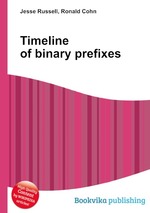Timeline of binary prefixes
Jesse Russell Ronald Cohn
бумажная книга
High Quality Content by WIKIPEDIA articles! This article presents a terminology timeline of binary prefixes. Early computers used two different approaches to memory addressing, representing the address as either a binary number or as a decimal number. Early machines that used decimal addressing included the ENIAC, UNIVAC 1, IBM 702, IBM 705, IBM 650, IBM 1400 series, and IBM 1620. Early binary addressed computers included Zuse Z3, Colossus, Whirlwind, AN/FSQ-7, IBM 701, IBM 704, IBM 709, IBM 7030, IBM 7090, IBM 7040, IBM System/360 and DEC PDP series. Decimal machines typically had memory configured in even decimal multiples (e.g., blocks of 100 and later 1000) and the abbreviation K or k, if it was used, had is normal meaning of 1000. Binary machine memory came in powers of two or small multiples of powers of two. In this context K or k was sometimes used to denote multiples of 1024 units or just the approximate size (e.g., `65K` for 65536 (216)). Early digital telephony established a standard of 8000 (`8K`) samples per second. This timeline lists early examples of these usages.


